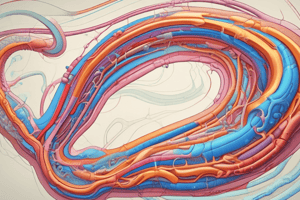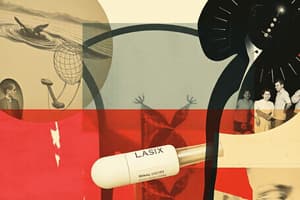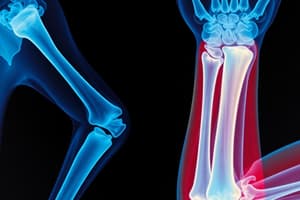Podcast
Questions and Answers
Which hormone, produced by the adrenal gland, directly interacts with transcription factors to regulate gene expression?
Which hormone, produced by the adrenal gland, directly interacts with transcription factors to regulate gene expression?
- Aldosterone (correct)
- Calmodulin
- Vasopressin
- Antidiuretic Hormone
How does an increase in blood volume due to water reabsorption typically affect blood pressure?
How does an increase in blood volume due to water reabsorption typically affect blood pressure?
- Leads to fluctuating blood pressure
- Increases blood pressure (correct)
- Causes no change in blood pressure
- Decreases blood pressure
What is the primary trigger for the release of aldosterone from the adrenal cortex?
What is the primary trigger for the release of aldosterone from the adrenal cortex?
- Hypokalemia
- Hyperkalemia (correct)
- Angiotensin-I
- Hyponatremia
Which of the following is NOT a direct effect of aldosterone on the kidneys?
Which of the following is NOT a direct effect of aldosterone on the kidneys?
Which of the following best describes the relationship between blood volume and renin production?
Which of the following best describes the relationship between blood volume and renin production?
What percentage of the original filtered water remains when the filtrate reaches the distal convoluted tubule?
What percentage of the original filtered water remains when the filtrate reaches the distal convoluted tubule?
Where does the majority of sodium reabsorption occur in the nephron?
Where does the majority of sodium reabsorption occur in the nephron?
What is the approximate osmolality of the filtrate as it enters the distal convoluted tubule?
What is the approximate osmolality of the filtrate as it enters the distal convoluted tubule?
Which mechanism plays a key role in maintaining the high osmolality of the medullary interstitium?
Which mechanism plays a key role in maintaining the high osmolality of the medullary interstitium?
What significant process occurs in the ascending limb of the loop of Henle?
What significant process occurs in the ascending limb of the loop of Henle?
What is the primary function of the vasa recta in the context of the counter-current mechanism?
What is the primary function of the vasa recta in the context of the counter-current mechanism?
Besides the PCT, where else is water significantly reabsorbed in the nephron?
Besides the PCT, where else is water significantly reabsorbed in the nephron?
Approximately how much sodium is left by the time the filtrate reaches the distal convoluted tubule?
Approximately how much sodium is left by the time the filtrate reaches the distal convoluted tubule?
What is a direct result of the Na+/K+/2Cl- transporter activity in the ascending limb?
What is a direct result of the Na+/K+/2Cl- transporter activity in the ascending limb?
What is the main process occurring in the proximal convoluted tubule?
What is the main process occurring in the proximal convoluted tubule?
What is the primary function of the sodium-potassium pump in the early distal convoluted tubule?
What is the primary function of the sodium-potassium pump in the early distal convoluted tubule?
Which of the following best describes the action of the sodium-chloride symporter in the early distal convoluted tubule?
Which of the following best describes the action of the sodium-chloride symporter in the early distal convoluted tubule?
What is the effect of thiazide diuretics on the early distal convoluted tubule?
What is the effect of thiazide diuretics on the early distal convoluted tubule?
Which hormone directly stimulates calcium reabsorption in the early distal convoluted tubule?
Which hormone directly stimulates calcium reabsorption in the early distal convoluted tubule?
What is the role of calbindin in the early distal convoluted tubule?
What is the role of calbindin in the early distal convoluted tubule?
Which of the following is a characteristic of the late distal convoluted tubule?
Which of the following is a characteristic of the late distal convoluted tubule?
What is the primary stimulus for the release of aldosterone from the adrenal gland?
What is the primary stimulus for the release of aldosterone from the adrenal gland?
How does aldosterone affect sodium transport in the late distal convoluted tubule?
How does aldosterone affect sodium transport in the late distal convoluted tubule?
What is the effect of aldosterone on potassium levels in the blood and urine?
What is the effect of aldosterone on potassium levels in the blood and urine?
Which mechanism best describes how calcium is transported from inside the early distal convoluted cells into the blood?
Which mechanism best describes how calcium is transported from inside the early distal convoluted cells into the blood?
How does Antidiuretic hormone (ADH) impact water reabsorption in the late distal convoluted tubule?
How does Antidiuretic hormone (ADH) impact water reabsorption in the late distal convoluted tubule?
Which of the following is a direct effect of parathyroid hormone (PTH) at the cell level in the early distal convoluted tubule?
Which of the following is a direct effect of parathyroid hormone (PTH) at the cell level in the early distal convoluted tubule?
Which of the following is NOT a stimulus for aldosterone release?
Which of the following is NOT a stimulus for aldosterone release?
What would be the effect of an inhibitor on the sodium-potassium pump in the early DCT?
What would be the effect of an inhibitor on the sodium-potassium pump in the early DCT?
Which of the following is the correct order of events in the early distal convoluted tubule when blood calcium levels are low?
Which of the following is the correct order of events in the early distal convoluted tubule when blood calcium levels are low?
Flashcards
Early Distal Tubule
Early Distal Tubule
The first section of the distal convoluted tubule (DCT), characterized by sodium reabsorption and potassium secretion.
Late Distal Tubule
Late Distal Tubule
The later part of the DCT responsible for regulated reabsorption of water under the influence of hormones. It's also involved in fine-tuning the balance of potassium and calcium.
Tubular Secretion
Tubular Secretion
The process of moving substances from the blood into the tubular fluid of the nephron, primarily in the proximal convoluted tubule (PCT) and the loop of Henle.
Tubular Reabsorption
Tubular Reabsorption
Signup and view all the flashcards
Descending Limb of Henle
Descending Limb of Henle
Signup and view all the flashcards
Ascending Limb of Henle
Ascending Limb of Henle
Signup and view all the flashcards
Counter-Current Multiplier Mechanism
Counter-Current Multiplier Mechanism
Signup and view all the flashcards
Vasa Recta
Vasa Recta
Signup and view all the flashcards
Counter-Current Exchanger
Counter-Current Exchanger
Signup and view all the flashcards
Passive Transport
Passive Transport
Signup and view all the flashcards
Aldosterone
Aldosterone
Signup and view all the flashcards
Vasopressin (ADH)
Vasopressin (ADH)
Signup and view all the flashcards
Hypokalemia
Hypokalemia
Signup and view all the flashcards
Angiotensin-I
Angiotensin-I
Signup and view all the flashcards
Sodium-Potassium Pump (DCT)
Sodium-Potassium Pump (DCT)
Signup and view all the flashcards
Sodium-Chloride Symporter (DCT)
Sodium-Chloride Symporter (DCT)
Signup and view all the flashcards
Thiazide Diuretics
Thiazide Diuretics
Signup and view all the flashcards
Parathyroid Hormone (PTH)
Parathyroid Hormone (PTH)
Signup and view all the flashcards
PTH Receptor (DCT)
PTH Receptor (DCT)
Signup and view all the flashcards
Cyclic AMP (cAMP)
Cyclic AMP (cAMP)
Signup and view all the flashcards
Protein Kinase A (DCT)
Protein Kinase A (DCT)
Signup and view all the flashcards
Calbindin
Calbindin
Signup and view all the flashcards
Ca2+/Na+ Transporter (DCT)
Ca2+/Na+ Transporter (DCT)
Signup and view all the flashcards
Ca2+/H+ Transporter (DCT)
Ca2+/H+ Transporter (DCT)
Signup and view all the flashcards
Sodium Channel (DCT)
Sodium Channel (DCT)
Signup and view all the flashcards
Na+/K+ Transporter (DCT)
Na+/K+ Transporter (DCT)
Signup and view all the flashcards
Potassium Channel (DCT)
Potassium Channel (DCT)
Signup and view all the flashcards
Antidiuretic Hormone (ADH)
Antidiuretic Hormone (ADH)
Signup and view all the flashcards
Aquaporins (DCT)
Aquaporins (DCT)
Signup and view all the flashcards
Study Notes
Renal Physiology: Distal Convoluted Tubule
- Distal Convoluted Tubule (DCT) Recap: The DCT is a crucial segment of the nephron for fine-tuning fluid and electrolyte balance.
- Early DCT: This section reabsorbs 5-6% of sodium and chloride ions. This process happens via Sodium-Chloride symporter.
- Sodium-Potassium Pump: This critical pump located on the basolateral membrane of the cells moves 3 sodium ions out and 2 potassium ions in, enabling Sodium-chloride's efficiency.
- Thiazide: A diuretic that inhibits the Sodium-Chloride symporter.
- Late DCT: This section is regulated by hormones, particularly aldosterone.
- Aldosterone: A steroid hormone that regulates sodium and potassium reabsorption in the collecting duct.
- Stimuli for Aldosterone Release: Angiotensin II, hyponatremia (low sodium levels), and hyperkalemia (high potassium levels) trigger the release of aldosterone.
- Aldosterone's Mechanism: It acts on the cells of the late DCT and collecting ducts to increase sodium reabsorption and potassium secretion thus maintaining electrolyte balance.
- Sodium Channels: Aldosterone stimulates the expression of specific sodium channels enabling efficient sodium reabsorption into the blood.
- Sodium-Potassium Transporter: This active transport system regulates intracellular sodium and potassium concentrations.
- Potassium Channels: Increased potassium reabsorption is triggered to maintain appropriate blood levels.
- Antidiuretic Hormone (ADH)/Vasopressin: ADH targets cells in the late DCT and collecting ducts to permit water reabsorption, influencing blood volume and pressure.
- Countercurrent Multiplier Mechanism: Vasa recta plays a role to keep the interstitial concentrations of sodium and urea high to promote water reabsorption.
Key Processes
- Tubular Reabsorption: The process of reclaiming essential substances from the filtrate and returning them to the blood.
- Tubular Secretion: The process of removing substances from the blood and adding them to the filtrate.
- Sodium Reabsorption: Active transport mechanism and channels facilitate this.
- Potassium Secretion: Importance for maintaining proper fluid and electrolyte balance.
- Water Reabsorption: Crucial for maintaining blood volume and pressure.
- Countercurrent Exchange: Essential in concentrating the urine.
Hormone Regulation
- Parathyroid Hormone (PTH): Regulates calcium reabsorption and phosphate excretion.
- Aldosterone: Regulates sodium and potassium reabsorption in the distal nephron.
- ADH (Vasopressin): Influences water reabsorption in the collecting ducts.
Studying That Suits You
Use AI to generate personalized quizzes and flashcards to suit your learning preferences.




